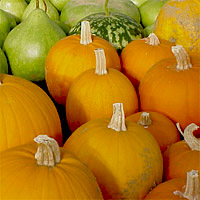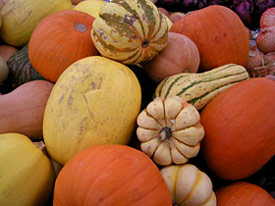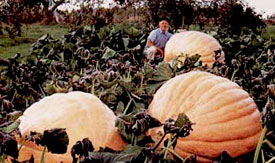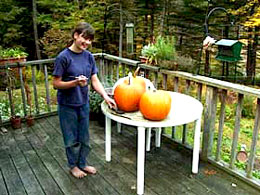
Ripe pumpkins are one of the sure signs of fall. For painting and carving, it's best to choose a variety with smooth skin.
No other vegetable says 'fall' like the pumpkin. This Native American fruit can range in size from a few ounces to more than 1000 pounds, depending on the variety. And pumpkins aren't necessarily orange. You can grow white and even blue pumpkins! Some varieties are perfect for making jack-o-lanterns and painting. Others are better suited for making pies and cooking. Some varieties are loaded with seeds that have thin hulls (often described as hulless), making them perfect for roasting into a healthy snack. Some varieties were bred for giant pumpkin competitions, while others are small and cute, and perfect for holiday decorating.
Whatever pumpkin variety you choose to grow, chances are you'll have some success with this easy-to-grow squash-family vine. I even had a self-sown pumpkin growing out of a wall near my asphalt driveway this summer. Curious as to what would happen, I let it grow and it produced a 10-pound fruit! So skip the farm stand next year and plant a pumpkin patch for you and your kids (or grandkids). Kids love to adopt the pumpkin fruits and you can have them carve their names on the young fruits and watch the carving expand with the pumpkin as it matures.
Planning
Choose pumpkin varieties based on their usage. Since these plants vine vigorously, find a location in full sun with fertile, well-drained soil and lots of room for them to roam. A few plants will produce enough pumpkins for most families.
Here are some of the best varieties to try. Days to maturity are listed for each.

Pumpkins are in the squash family. While we traditionally use the orange pumpkin for carving and pies, many winter squash work just as well.

If you're ambitious, you can grow these 'Atlantic Giant' pumpkins. The world record holder is over 1600 pounds. That's a lot of pies!
Pumpkins and all winter squash grow best in full sun in regions with warm, moderately moist summers. They like high fertility, so amend the soil with a 2- to 3-inch layer of compost before planting. In cool-summer areas you may want to start plants indoors 4 weeks before your last frost date to get a jump on the season. Also, in cool areas lay black plastic mulch over the planting bed a few weeks before the last frost date. Poke holes in the plastic to plant the pumpkin seeds or plants.
In all areas, sow seeds when the soil has warmed to 60 degrees F. Sow seeds 2 to 4 feet apart in rows 5 to 8 feet apart. Or plant 5 to 7 seeds in hills spaced 4 feet apart.
Care
Pumpkins need water to keep them growing strong. Apply 1 to 2 inches of water per week -- more during dry periods. While pumpkin vines will eventually fill a large area, when young they need to be weeded regularly to give them a strong start. Cultivate lightly around plants with a hoe. Avoid disturbing the pumpkins' shallow roots. Unless you're growing them on black plastic, mulch plants with straw once five leaves form.

In addition to applying compost before planting, side-dress pumpkins once the vines start running with a high nitrogen fertilizer, such as alfalfa meal.
If you want to form just a few large fruits per vine, pinch off pumpkin blossoms and small fruits that form after two or three early fruit have set. The plants will send more energy into the remaining fruits and they will grow larger. Plus, in cool summer areas these later fruits wouldn't have time to mature before frost anyway.
Some gardeners worry that their pumpkin plants will cross-pollinate with other squash plants. Although pumpkins can cross-pollinate with other squash-family crops, it's not a concern unless you try to save the seeds from this year's crop and sow them next year. If you do save and plant the seeds next year it's likely you'll get some odd-looking fruits in the pumpkin patch.
Pumpkins have few insect and disease problems. Squash vine borers sometimes tunnel into pumpkin vines, opening the vines to disease and rotting. Cover young plants with a floating row cover to prevent the adult fly from laying eggs in spring. Remove larvae in the stems with a sharp knife or inject Bacillus thuriengensis (B.t.) into the stems to kill the larvae. Squash bugs can feed on leaves, but are only a problem if they occur early in the season. Spray a botanical pesticide to control them. To keep diseases at bay, leave lots of space between plants, keep the patch weed free, and select disease-resistant varieties.
Harvest
Leave pumpkins on the vine until they size up and turn the appropriate skin color for that variety. Pumpkins will continue to mature after picking, but color up best if left on the vine for as long as possible. Harvest all your pumpkins before the first hard frost. To harvest, cut the stems 2 inches above the fruits with a sharp knife. Carefully remove the fruits, taking care not to nick the skin. Damaged fruits won't last long in storage. Wipe the skin clean with a mild bleach solution to kill any disease spores. To help pumpkins last longer, cure the fruits by placing them in an 80- to 85-degree F, humid room for two weeks. Store in a 50- to 55-degree F, dark location. Most pumpkins can be stored for 2 to 3 months under proper conditions.
 Charlie Nardozzi is an award winning, nationally recognized garden writer, speaker, radio, and television personality. He has worked for more than 30 years bringing expert gardening information to home gardeners through radio, television, talks, tours, on-line, and the printed page. Charlie delights in making gardening information simple, easy, fun and accessible to everyone. He's the author of 6 books, has three radio shows in New England and a TV show. He leads Garden Tours around the world and consults with organizations and companies about gardening programs. See more about him at Gardening With Charlie.
Charlie Nardozzi is an award winning, nationally recognized garden writer, speaker, radio, and television personality. He has worked for more than 30 years bringing expert gardening information to home gardeners through radio, television, talks, tours, on-line, and the printed page. Charlie delights in making gardening information simple, easy, fun and accessible to everyone. He's the author of 6 books, has three radio shows in New England and a TV show. He leads Garden Tours around the world and consults with organizations and companies about gardening programs. See more about him at Gardening With Charlie.
 Victory Seed Company has all the seeds you want for your best garden in 2024.
Victory Seed Company has all the seeds you want for your best garden in 2024.
For 25 years, the family-owned Victory Seed Company has provided the highest quality vegetable, herb and flower seeds to families across the country. We are passionate about providing you the best seeds available that give excellent germination, robust plants, and the harvest you want. With a catalog of over a thousand varieties, we have everything, and our prices are the kinds that we'd want to pay. We have hundreds of yesterday's heirloom vegetables, as well as today's award winning hybrid selections. Get to know us by visiting our website and browsing through our online vegetable seed catalog.